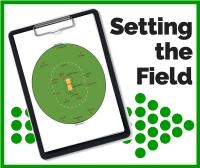Bowling Tactics: How to "Bowl Dry"
 Frustration: An underrated way to get wickets, and enormously effective at any level. In recent years, this has been called “squeezing” or “bowling dry”.
Frustration: An underrated way to get wickets, and enormously effective at any level. In recent years, this has been called “squeezing” or “bowling dry”.
How do you bowl dry this way?
Kohli's Wonderful Field Settings
 I watched some Test cricket in Mumbai this week, it was enthralling viewing. All 28 minutes of it!
I watched some Test cricket in Mumbai this week, it was enthralling viewing. All 28 minutes of it!
How to Captain: Placing the Fielders
This is part three of a series on how to captain in the field. To go to part one click here. To go back to the introduction click here.
Along with bowling changes, field placing is the other obvious part of captaincy in the field.
The simple way to look at it is to put the fielders where you think the ball is most likely to go (not always just where it has gone).
How do you do that without resorting to the stock fields that everyone uses?
Before we get into that, a word about orthodox fields: They are orthodox because they have been proven to work over the test of time. Slips remain in place because batsmen through the ages continue to edge the ball wide of the wicketkeeper. Mid on and mid off exist because even the most extreme Twenty20 specialists play shots with a straight bat sometimes.
That said it's important not to mindlessly follow what you consider the norm. Just because every captain in your club starts the game with a couple of slips, a gulley and a saving one field it does not mean you should.
For the basic theory of field placing take a look at my article here.
Once you have that in your mind, let's go back to the basic aim of field placing: Putting your players where you think the ball will go.
Tactics You Should Be Using: Funky Field Settings
In the first Ashes Test of 2015, England brought in another weird fielding position: the silly slip.
Joe Root, helmet-clad, took a position at third slip that was far too close for comfort. It was reasonable considering the slow pitch and the low chance of an edge carrying to orthodox third slip. Successful or not, it is another in the long line of "funky" fielding positions that span back to the 1970s (at least).
Yet, club and school cricket remains staunchly formulaic. Is there something we can learn from the pros here?
Cricket Show S6 Episode 5: Fielding In The Box
| Attachment | Size |
|---|---|
| PitchVision Academy - PitchVision Academy Cricket Show 296.mp3 | 30.99 MB |

David Hinchliffe chats to coaches Mark Garaway and Sam Lavery. The cricket topics start with a discussion about the difference between skill, and skill under pressure. Listen in for the team's solutions.
Then the show moves on to field settings for Twenty20 leg spin bowlers. Both Garas and Lavers came up with the same field.
Set Up: Knock Down: A Leg Spin Field Tactic
 Max Andrews is a freelance coach on PitchVision Academy, in this article he talks us through the mysteries of spin bowling tactics.
Max Andrews is a freelance coach on PitchVision Academy, in this article he talks us through the mysteries of spin bowling tactics.
There is a lot of information on the the correct action to be able to bowl well. But it is very difficult to find information on how to bowl in match scenarios, and what fields to set.
Setting the Field: Theory and Practice
 From orthodox to funky; being a better captain and bowler means mastering the art of setting the field in your cricket matches.
From orthodox to funky; being a better captain and bowler means mastering the art of setting the field in your cricket matches.
Chances are you know fields that suit certain bowlers and match situations. There is much more to it that that though. There are some underlying principles of field setting that allow you to become more flexible while basing everything in solid logic.
The result of understanding the core of field setting is that you can have the right players in the right places at the right time. And that's going to get you more wickets.
Field Settings: Hook, Line and Sinker
Hook, line and sinker: literally.
Using a "leg theory" approach, and the English desire to win by hooking, Dhoni won the 2nd Test against England.
Could it work for you too?
I'm going to say yes.
In certain situations, you can use a similar tactic. It's risky, but Dhoni and Sharma proved that it can win you games when orthodox tactics are seeing you cruise to defeat.
Lets look at the details.
Good Enough for Dhoni: 4 More Village Tactics to Try
 In the 2nd Test against England, Dhoni stood back to the spinner.
In the 2nd Test against England, Dhoni stood back to the spinner.
It's a tactic regularly employed in lower standard games where the keeper doesn't have the confidence to stand up. In short, it's village cricket.
But there was a method in the madness.
The Tabletop Cricket Approach to Field Settings
Was this brilliance or madness?
As the first Test against Sri Lanka meandered to a draw, England needed wickets. So, Alastair Cook took a leaf from the old tabletop cricket game, and set a ring of fielders in front of the batsman.
The field looked like this:

